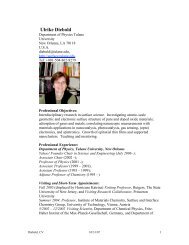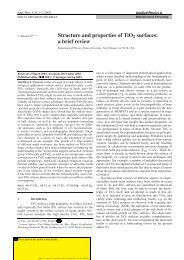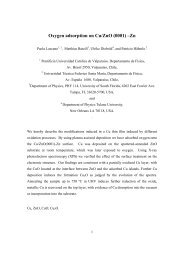The surface science of titanium dioxide - Niser
The surface science of titanium dioxide - Niser
The surface science of titanium dioxide - Niser
You also want an ePaper? Increase the reach of your titles
YUMPU automatically turns print PDFs into web optimized ePapers that Google loves.
68 U. Diebold / Surface Science Reports 48 (2003) 53±229<br />
Fig. 4. Phase diagram <strong>of</strong> the Ti±O system taken from Samsonov [65]. <strong>The</strong> region Ti 2 O 3 ±TiO 2 contains Ti 2 O 3 ,Ti 3 O 5 ,seven<br />
discrete phases <strong>of</strong> the homologous series Ti n O 2n 1 (Magneli phases), and TiO 2 . See [65] for a more detailed description.<br />
<strong>The</strong> two approaches that are commonlyused to predict the structure and stability<strong>of</strong> oxide <strong>surface</strong>s are<br />
exempli®ed in detail for the rutile (1 1 0) <strong>surface</strong>. For anatase, the (1 0 1) and the (1 0 0)/(0 1 0) <strong>surface</strong><br />
planes are found in powder materials, together with some (0 0 1). <strong>The</strong> (1 0 1) <strong>surface</strong> was calculated to<br />
have the lowest <strong>surface</strong> energy, even lower than the rutile (1 1 0) <strong>surface</strong> [70]. First experimental results<br />
on anatase (0 0 1) and (1 0 1) are discussed at the end <strong>of</strong> this section.<br />
2.1.1. Bulk defects<br />
<strong>The</strong> <strong>titanium</strong>±oxygen phase diagram is very rich with many stable phases with a variety <strong>of</strong> crystal<br />
structures, see Fig. 4 [65]. Consequently, TiO 2 can be reduced easily. Bulk reduction and the resulting<br />
color centers are re¯ected in a pronounced color change <strong>of</strong> TiO 2 single crystals from initially<br />
transparent to light and, eventually, dark blue, see Fig. 5. <strong>The</strong>se intrinsic defects result in n-type doping<br />
and high conductivity, see Table 2. <strong>The</strong> high conductivitymakes TiO 2 single crystals such a convenient<br />
oxide system for experimentalists.<br />
As has been pointed out recently [71], bulk defects playa major role in a variety<strong>of</strong> <strong>surface</strong><br />
phenomena where annealing to high temperatures is necessary, e.g. during the encapsulation <strong>of</strong> Pt<br />
[18,20,72], in bulk-assisted reoxidation [73,74], in restructuring and reconstruction processes [75,76],<br />
and adsorption <strong>of</strong> sulfur and other inorganic compounds [77]. <strong>The</strong> relationship between crystal color,<br />
conductivity, bulk defects as characterized by EPR measurements, and <strong>surface</strong> structure <strong>of</strong> rutile (1 1 0)<br />
has been investigated systematically by Li et al. [71], and the samples reproduced in Fig. 5 have been<br />
used in this study. <strong>The</strong> electric properties in dependence on the bulk defect concentration has been<br />
investigated in [78,79].<br />
<strong>The</strong> bulk structure <strong>of</strong> reduced TiO 2 x crystals is quite complex with a various types <strong>of</strong> defects such as<br />
doublycharged oxygen vacancies, Ti 3‡ and Ti 4‡ interstitials, and planar defects such as CSPs. <strong>The</strong><br />
defect structure varies with oxygen de®ciency which depends on temperature, gas pressure, impurities,<br />
etc. Despite years <strong>of</strong> research, the question <strong>of</strong> which type <strong>of</strong> defect is dominant in which region <strong>of</strong><br />
oxygen de®ciency is still subject to debate [78,80]. It was shown that the dominant type are Ti<br />
interstitials in the region from TiO 1.9996 to TiO 1.9999 (from 3:7 10 18 to 1:3 19 19 missing O atoms







